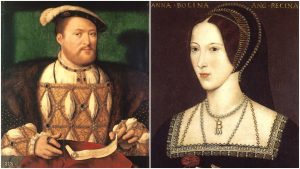 I’ve just come back from a two week holiday travelling through Spain and France to the UK, and while I was in the UK I was lucky enough to attend David Starkey’s talk “Henry VIII: The First Brexiteer” at the Festival Theatre at Hever Castle. It was a wonderful talk, both entertaining and educational, and in it Dr Starkey shared his view on the dating of Anne Boleyn’s acceptance of Henry VIII’s proposal of marriage. It is something that he has mentioned before in his book on the six wives, but I haven’t discussed it here on the Anne Boleyn Files before so I thought I’d share it with you.
I’ve just come back from a two week holiday travelling through Spain and France to the UK, and while I was in the UK I was lucky enough to attend David Starkey’s talk “Henry VIII: The First Brexiteer” at the Festival Theatre at Hever Castle. It was a wonderful talk, both entertaining and educational, and in it Dr Starkey shared his view on the dating of Anne Boleyn’s acceptance of Henry VIII’s proposal of marriage. It is something that he has mentioned before in his book on the six wives, but I haven’t discussed it here on the Anne Boleyn Files before so I thought I’d share it with you.
As Dr Starkey explained, and as many of you will know, Henry VIII’s love letters to Anne Boleyn, which are held now in the Vatican Archives, are not dated. There are several theories regarding the order in which they were written and when they were written, but only David Starkey, I believe, goes as far as to give a firm date for Anne’s acceptance of the king’s proposal, which she signified by sending him a jewelled trinket. Henry VIII described it in his letter as “the costly Diamond, and the Ship in which the solitary Damsel is tossed about”. Henry thanked Anne for the gift, “but chiefly for the fine interpretation, and too humble submission”, i.e. for her submission to his will. Eric Ives explains that “For centuries the ship had been a symbol of protection – the ark which rescued Noah from the destroying deluge; the diamond – as the Roman de la Rose had said – spoke of a ‘heart as hard as diamond, steadfast and nothing pliant’.”
Now, this letter was written in French, and this is where things get interesting. As Ives and Starkey both point out, Henry VIII thanks Anne for “l’etrene [étrenne]”, rather than “le cadeau”. If you don’t know French, “cadeau” means gift or present and so does “étrenne”. However, “étrennes” are more specific than “cadeaux”, they are usually gifts given at New Year. Starkey believes, therefore, that Anne said “yes” to Henry VIII on 1st January 1527, 1527 fitting with the king’s claim that he had been in love with her for a year. Eric Ives talks about the use of “étrenne” in the letter, stating that “the word was acquiring an implication of ‘novelty’ or ‘special occasion'”, but that it “was also developing a second meaning – ‘virginity’.” Ives believes that by using this word, rather than “cadeau”, “Henry could be picking up on Anne’s assertion that her maidenhead was reserved for her future husband” and that by giving Henry this gift, and thereby accepting his proposal, she was offering her maidenhead to him. Interesting!
So, Starkey dates the acceptance to 1st January 1527 and the start of Henry’s interest in Anne to 1525, but what does Eric Ives think? Well, he believes that Henry began his “courtly pursuit” of Anne at Shrovetide 1526 and that the couple agreed to marry in summer 1527. Does it matter? Well, as Ives points out, if you go with the earlier date then you make Anne “the catalyst for the rejection of Katherine”, whereas if you go with the later dating then it’s two years after Henry had ceased to have sexual relations with his first wife, and Anne is more of a solution to the king’s matrimonial woes rather than a cause.
I’d love to hear your thoughts on this so please do leave a comment.
Sources
- “Henry VIII: The First Brexiteer”, talk by Dr David Starkey at the Festival Theatre, Hever Castle, 8 August 2018.
- ed. Oldys, William (1745) The Harleian miscellany: or, A collection of scarce, curious, and entertaining pamphlets and tracts, as well in manuscript as in print, Volume III, p. 54, Lettre V. This can be read at https://archive.org/stream/harleianmiscella03oldyiala#page/54/mode/2up
- Ives, Eric (2004) The Life and Death of Anne Boleyn, Blackwell Publishing, p. 88-90.